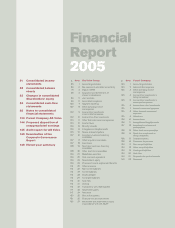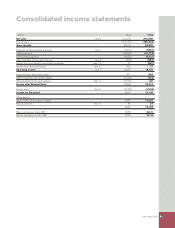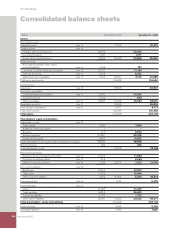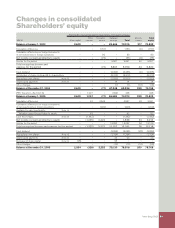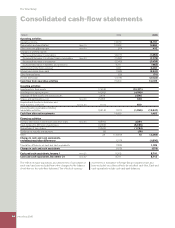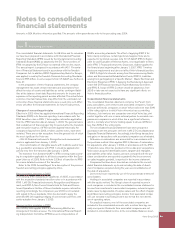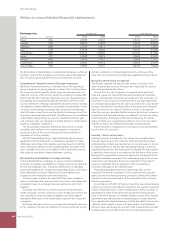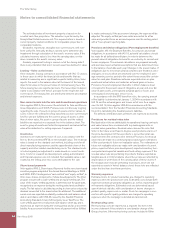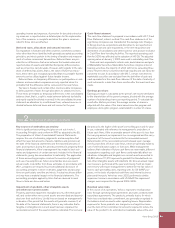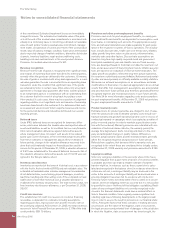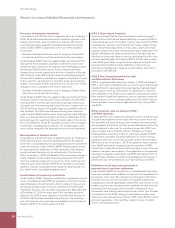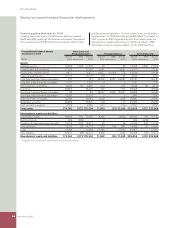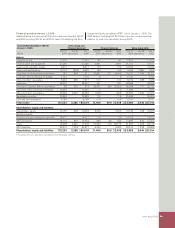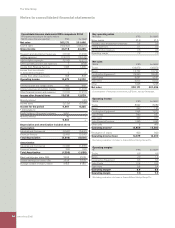Volvo 2005 Annual Report Download - page 93
Download and view the complete annual report
Please find page 93 of the 2005 Volvo annual report below. You can navigate through the pages in the report by either clicking on the pages listed below, or by using the keyword search tool below to find specific information within the annual report.
Volvo Group 2005 89
operating income and expenses. A provision for decided restructur-
ing measures is reported when a detailed plan for the implementa-
tion of the measures is complete and when this plan is communi-
cated to those who are affected.
Deferred taxes, allocations and untaxed reserves
Tax legislation in Sweden and other countries sometimes contains
rules other than those identifi ed with generally accepted accounting
principles, and which pertain to the timing of taxation and measure-
ment of certain commercial transactions. Deferred taxes are pro-
vided for on differences that arise between the taxable value and
reported value of assets and liabilities (temporary differences) as
well as on tax-loss carryforwards. However, with regards to the valu-
ation of deferred tax assets, that is, the value of future tax reduc-
tions, these items are recognized provided that it is probable that the
amounts can be utilized against future taxable income.
Deferred taxes on temporary differences on participations in sub-
sidiaries and associated companies are only reported when it is
probable that the difference will be recovered in the near future.
Tax laws in Sweden and certain other countries allow companies
to defer payment of taxes through allocations to untaxed reserves.
These items are treated as temporary differences in the consolidat ed
balance sheet, that is, a split is made between deferred tax liability
and equity capital (restricted reserves). In the consolidated income
statement an allocation to, or withdrawal from, untaxed reserves is
divided between deferred taxes and net income for the year.
Cash-fl ow statement
The cash-fl ow statement is prepared in accordance with IAS 7, Cash
Flow Statement, indirect method. The cash-fl ow statements of for-
eign Group companies are translated at the average rate. Changes
in Group structure, acquisitions and divestments, are reported net,
excluding cash and cash equivalents, in the item Acquisition and
divestment of subsidiaries and other business units and are included
in Cash Flow from Investing Activities. The reported operating cash
fl ow for 2005 was affected by the adoption of IAS 39. The adjusted
opening value at January 1, 2005 was used in calculating cash fl ow.
Cash and cash equivalents include cash, bank balances and parts
of Marketable Securities. Marketable Securities comprise interest-
bearing securities, the majority of which with terms exceeding three
years. However, these securities have high liquidity and can easily be
converted to cash. In accordance with IAS 7, certain investment in
marketable securities are excluded from the defi nition of cash and
cash equivalents in the cash-fl ow statement if the date of maturity of
such instruments is later than three months after the investment was
made.
Earnings per share
Earnings per share is calculated as the period’s net income attributed
to the shareholders of the parent company, divided with the average
number of outstanding shares per reporting period. To calculate the
result after dilution per share, the average number of shares is
adjusted with the value of the share based incentive program and
employee stock option program recalculated to number of shares.
Note 2 Key sources of estimation uncertainty
Key sources of estimation uncertainty
Volvo’s signifi cant accounting principles are set out in note 1,
Accounting Principles and conform to IFRS as adopted by the EU.
The preparation of Volvo’s Consolidated Financial Statements
requires the use of estimates, judgements and assumptions that
affect the reported amounts of assets, liabilities and provisions at
the date of the fi nancial statements and the reported amounts of
sales and expenses during the periods presented. In preparing these
fi nancial statements, Volvo’s management has made its best esti-
mates and judgements of certain amounts included in the fi nancial
statements, giving due consideration to materiality. The application
of these accounting principles involves the exercise of judgement
and use of assumptions as future uncertainties and, as a result,
actual results could differ from these estimates. In accordance with
IAS 1, preparers are required to provide additional disclosure of
accounting principles in which estimates, judgments and assump-
tions are particularly sensitive and which, if actual results are differ-
ent, may have a material impact on the fi nancial statements. The
accounting principles applied by Volvo that are deemed to meet
these criteria are discussed below:
Impairment of goodwill, other intangible assets
and other non-current assets
Property, plant and equipment, intangible assets, other than good-
will, and certain other non-current assets are amortized and depreci-
ated over their useful lives. Useful lives are based on management’s
estimates of the period that the assets will generate revenue. If, at
the date of the fi nancial statements, there is any indication that a
tangible or intangible non-current asset has been impaired, the
recoverable amount of the asset should be estimated. The recovera-
ble amount is the higher of the asset’s net selling price and its value
in use, estimated with reference to management’s projections of
future cash fl ows. If the recoverable amount of the asset is less than
the carrying amount, an impairment loss is recognized and the carry-
ing amount of the asset is reduced to the recoverable amount.
Determination of the recoverable amount is based upon manage-
ment’s projections of future cash fl ows, which are generally made by
use of internal business plans or forecasts. While management
believes that estimates of future cash fl ows are reasonable, different
assumptions regarding such cash fl ows could materially affect our
valuations. Intangible and tangible non-current assets amounted to
55,840 whereof 11,072 represents goodwill. For Goodwill and cer-
tain other intangible assets with indefi nite life-time an annual impair-
ment review is performed at the year-end closing. Such an impair-
ment review will require management to determine the fair value of
Volvo’s cash generating units, reporting units for US GAAP pur-
poses, on the basis of projected cash fl ows and internal business
plans and forecasts. Volvo has since 2002 performed a simliar
impairment review in accordance with US GAAP. No impairment
charges were required for the period 2002–2005.
Residual value risks
In the course of its operations, Volvo is exposed to residual value
risks through operating lease agreements and sales combined with
repurchase agreements. The products, primarily trucks, for which
Volvo has a residual value commitment, are generally recognized in
the balance sheet as assets under operating leases. Depreciation
expenses for these products are charged on a straight-line basis
over the term of the commitment in amounts required to reduce the
value of the product to its estimated net realizable value at the end



